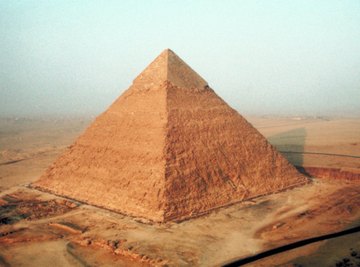
All pyramids feature a base with three or more sides, a pointy top (or apex) and sides that come up from the base to form the apex. Many different types of pyramids exist, and mathematicians classify them by the form of the base. For example, a pyramid with a square base is a square-based pyramid, and a pyramid with a triangle base is a triangular-based pyramid. One property that all types of pyramids have in common is that their sides are triangular.
Faces
Triangular-based pyramids are formed exclusively from triangles. Three triangular sides slant upwards from the triangular base. Because it is formed from four triangles, a triangular-based pyramid is also known as a tetrahedron. If all of the faces are equilateral triangles, or triangles whose edges are all the same lengths, the pyramid is termed a regular tetrahedron. If the triangles have edges of different lengths, the pyramid is an irregular tetrahedron.
Edges
Triangular-based pyramids have six edges, three along the base and three extending up from the base. If the six edges are of equal length, all of the triangles are equilateral, and the pyramid is a regular tetrahedron.
Vertices
In geometry, vertices are essentially corners. All triangular-based pyramids, whether they are regular or irregular, have four vertices.
Surface Area
To determine the surface area of a triangular-based pyramid, add together the area of the base plus the area of all of the sides. For regular tetrahedra, this calculation is simple. Find the length of the base and the height of one of the triangles. Multiply these measurements together and divide this number by two. This is the area of one of the triangles. Then, multiply this area by four to account for all of the triangular faces on the pyramid. For irregular tetrahedra, find the area of each triangle individually, using the formula 1/2 times base times height. Then, add all of the areas together.
Volume
To determine the volume of any triangular-based pyramid, multiply the area of the triangular base by the height of the pyramid (measured from the base to the apex). Then, divide this number by three.
References
About the Author
Kat Black is a professional writer currently completing her doctorate in musicology/ She has won several prestigious awards for her research, and has had extensive training in classical music and dance.
Photo Credits
NA/AbleStock.com/Getty Images
